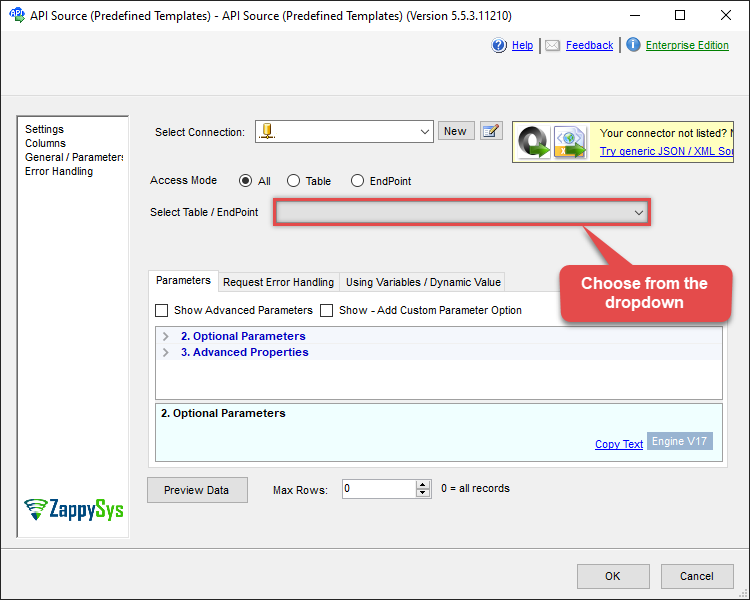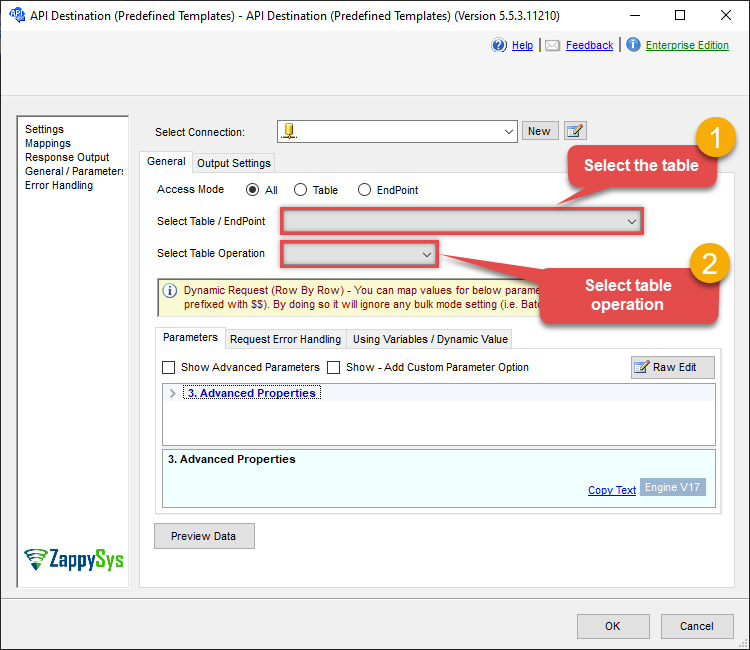Endpoint Get Customers
Name
get_customers
Description
Gets a list of customers. [API reference]
Related Tables
Parameters
| Parameter | Required | Options | ||||||||||||||||||||||||||||||||||||||||||||||||
|---|---|---|---|---|---|---|---|---|---|---|---|---|---|---|---|---|---|---|---|---|---|---|---|---|---|---|---|---|---|---|---|---|---|---|---|---|---|---|---|---|---|---|---|---|---|---|---|---|---|---|
|
Name:
Label: Customer Id(s) - Comma separated Restrict results to records specified by a comma-separated list of IDs. Max IDs per request controlled by BatchSize property (found in PaginationParams) |
||||||||||||||||||||||||||||||||||||||||||||||||||
|
Name:
Label: Since Customer Id Restrict results to those created after the specified customer ID. |
||||||||||||||||||||||||||||||||||||||||||||||||||
|
Name:
Label: Page Size The maximum number of records to show. |
||||||||||||||||||||||||||||||||||||||||||||||||||
|
Name:
Label: Only Fields to Show Limit data retrieval to only the selected customer-related fields. |
|
|||||||||||||||||||||||||||||||||||||||||||||||||
|
Name:
Label: Created Before Restrict results to records created before a specified date. (format: 2014-04-25T16:15:47). Supported options are the following: now|today|yesterday|weekstart|weekend|monthstart|monthend|yearstart|yearend and supported intervals for add/subtract are ms|s|sec|min|h|hour|y|year|d|day|m|month|y|year. Example monthstart-3d (subtract 3 days from month start) |
|
|||||||||||||||||||||||||||||||||||||||||||||||||
|
Name:
Label: Created After Restrict results to records created after a specified date. (format: 2014-04-25T16:15:47). Supported options are the following: now|today|yesterday|weekstart|weekend|monthstart|monthend|yearstart|yearend and supported intervals for add/subtract are ms|s|sec|min|h|hour|y|year|d|day|m|month|y|year. Example monthstart-3d (subtract 3 days from month start) |
|
|||||||||||||||||||||||||||||||||||||||||||||||||
|
Name:
Label: Updated Before Restrict results to records last updated before a specified date. (format: 2014-04-25T16:15:47). Supported options are the following: now|today|yesterday|weekstart|weekend|monthstart|monthend|yearstart|yearend and supported intervals for add/subtract are ms|s|sec|min|h|hour|y|year|d|day|m|month|y|year. Example monthstart-3d (subtract 3 days from month start) |
|
|||||||||||||||||||||||||||||||||||||||||||||||||
|
Name:
Label: Updated After Restrict results to records last updated after a specified date. (format: 2014-04-25T16:15:47). Supported options are the following: now|today|yesterday|weekstart|weekend|monthstart|monthend|yearstart|yearend and supported intervals for add/subtract are ms|s|sec|min|h|hour|y|year|d|day|m|month|y|year. Example monthstart-3d (subtract 3 days from month start) |
|
Output Columns
| Label | Data Type (SSIS) | Data Type (SQL) | Length | Description |
|---|---|---|---|---|
| Id |
DT_I8
|
bigint
|
||
DT_WSTR
|
nvarchar(255)
|
255 | ||
| AcceptsMarketing |
DT_BOOL
|
bit
|
||
| CreatedAt |
DT_DBTIMESTAMP
|
datetime
|
||
| UpdatedAt |
DT_DBTIMESTAMP
|
datetime
|
||
| FirstName |
DT_WSTR
|
nvarchar(255)
|
255 | |
| LastName |
DT_WSTR
|
nvarchar(255)
|
255 | |
| OrdersCount |
DT_I4
|
int
|
||
| State |
DT_WSTR
|
nvarchar(255)
|
255 | |
| TotalSpent |
DT_WSTR
|
nvarchar(50)
|
50 | |
| LastOrderId |
DT_I8
|
bigint
|
||
| Note |
DT_WSTR
|
nvarchar(4000)
|
4000 | |
| VerifiedEmail |
DT_BOOL
|
bit
|
||
| MultipassIdentifier |
DT_WSTR
|
nvarchar(255)
|
255 | |
| TaxExempt |
DT_BOOL
|
bit
|
||
| TaxExemptions |
DT_WSTR
|
nvarchar(4000)
|
4000 | |
| Tags |
DT_WSTR
|
nvarchar(4000)
|
4000 | |
| LastOrderName |
DT_WSTR
|
nvarchar(255)
|
255 | |
| Currency |
DT_WSTR
|
nvarchar(20)
|
20 | |
| Phone |
DT_WSTR
|
nvarchar(30)
|
30 | |
| AcceptsMarketingUpdatedAt |
DT_DBTIMESTAMP
|
datetime
|
||
| MarketingOptInLevel |
DT_WSTR
|
nvarchar(255)
|
255 | |
| SMSMarketingConsent |
DT_WSTR
|
nvarchar(255)
|
255 | |
| AdminGraphQLApiId |
DT_WSTR
|
nvarchar(255)
|
255 | |
| DefaultAddressId |
DT_WSTR
|
nvarchar(255)
|
255 | |
| DefaultAddressCustomerId |
DT_WSTR
|
nvarchar(255)
|
255 | |
| DefaultAddressFirstName |
DT_WSTR
|
nvarchar(255)
|
255 | |
| DefaultAddressLastName |
DT_WSTR
|
nvarchar(255)
|
255 | |
| DefaultAddressCompany |
DT_WSTR
|
nvarchar(255)
|
255 | |
| DefaultAddressAddress1 |
DT_WSTR
|
nvarchar(255)
|
255 | |
| DefaultAddressAddress2 |
DT_WSTR
|
nvarchar(255)
|
255 | |
| DefaultAddressCity |
DT_WSTR
|
nvarchar(255)
|
255 | |
| DefaultAddressProvince |
DT_WSTR
|
nvarchar(255)
|
255 | |
| DefaultAddressCountry |
DT_WSTR
|
nvarchar(255)
|
255 | |
| DefaultAddressZip |
DT_WSTR
|
nvarchar(255)
|
255 | |
| DefaultAddressPhone |
DT_WSTR
|
nvarchar(255)
|
255 | |
| DefaultAddressName |
DT_WSTR
|
nvarchar(255)
|
255 | |
| DefaultAddressProvinceCode |
DT_WSTR
|
nvarchar(255)
|
255 | |
| DefaultAddressCountryCode |
DT_WSTR
|
nvarchar(255)
|
255 | |
| DefaultAddressCountryName |
DT_WSTR
|
nvarchar(255)
|
255 | |
| EmailMarketingConsentState |
DT_WSTR
|
nvarchar(255)
|
255 | |
| EmailMarketingConsentOptInLevel |
DT_WSTR
|
nvarchar(255)
|
255 | |
| EmailMarketingConsentUpdatedAt |
DT_DBTIMESTAMP
|
datetime
|
Input Columns
| Label | Data Type (SSIS) | Data Type (SQL) | Length | Description |
|---|---|---|---|---|
| CustomerId |
DT_I8
|
bigint
|
Examples
SSIS
Use Shopify Connector in API Source or in API Destination SSIS Data Flow components to read or write data.
API Source
This Endpoint belongs to the Customers table, therefore it is better to use it, instead of accessing the endpoint directly:
| Optional Parameters | |
|---|---|
| Customer Id(s) - Comma separated | |

API Destination
This Endpoint belongs to the Customers table, therefore it is better to use it, instead of accessing the endpoint directly. Use this table and table-operation pair to get customers:
| Optional Parameters | |
|---|---|
| Customer Id(s) - Comma separated | |

ODBC application
Use these SQL queries in your ODBC application data source:
Get list of customers
SELECT * FROM CustomersGet multiple specific customers by their IDs
SELECT * FROM Customers
WITH (ids='1111111111111,2222222222222,3333333333333')Get a specific customer by its ID
SELECT * FROM Customers Where Id=12345
get_customers endpoint belongs to
Customers
table(s), and can therefore be used via those table(s).
SQL Server
Use these SQL queries in SQL Server after you create a data source in Data Gateway:
Get list of customers
DECLARE @MyQuery NVARCHAR(MAX) = 'SELECT * FROM Customers';
EXEC (@MyQuery) AT [LS_TO_SHOPIFY_IN_GATEWAY];Get multiple specific customers by their IDs
DECLARE @MyQuery NVARCHAR(MAX) = 'SELECT * FROM Customers
WITH (ids=''1111111111111,2222222222222,3333333333333'')';
EXEC (@MyQuery) AT [LS_TO_SHOPIFY_IN_GATEWAY];Get a specific customer by its ID
DECLARE @MyQuery NVARCHAR(MAX) = 'SELECT * FROM Customers Where Id=12345';
EXEC (@MyQuery) AT [LS_TO_SHOPIFY_IN_GATEWAY];
get_customers endpoint belongs to
Customers
table(s), and can therefore be used via those table(s).
